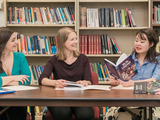Impacting US Schooling
UMBC researchers from across the humanities and social sciences recently earned press coverage for their work exploring factors that shape K–12 education in the United States. From inclusive language in classrooms to math pedagogy, each offers insights to spur change and further research to improve children’s educational experiences.
Christine Mallinson, professor of language, literacy, and culture, writes in The Conversation about how language differences among students can affect student outcomes. “Studies have found that at all levels of education, instructors often favor students who sound like themselves and can be biased against those who don’t,” writes Mallinson. Compounding the problem, “As the U.S. student population continues to rapidly diversify along cultural and linguistic lines, the demographics of the teacher population remain stable at roughly 82 percent white and predominantly female,” meaning non-white students experience negative bias more often.
Mallinson explains that students who are repeatedly told their way of speaking is wrong internalize that message, which may result in students speaking up less often in class. To help educators take on this challenge, Mallinson and colleagues developed a series of webinars, a podcast, and an app called “Valuable Voices” replete with classroom exercises to help students and educators understand and value linguistic diversity.
“Ensuring that students, peers and teachers from diverse backgrounds understand and communicate respectfully with each other is often just as important as helping students understand the material in their textbooks,” writes Mallinson. “Language matters—not just for fostering mutual respect, but for making sure that every student has an equal opportunity to succeed.”
Prior to Hurricane Katrina, the New Orleans Public School System bucked the trend in teacher demographics that Mallinson notes, with a teacher workforce that identified as 71 percent African American serving a predominantly African American student body. However, immediately following Katrina, substantial school system restructuring deeply impacted the teacher workforce, and by 2014, fewer than 50 percent of city teachers were black.
Jane Arnold Lincove, associate professor of public policy, detailed how teacher demographics changed in New Orleans after Katrina in a new study featured in The Hechinger Report. The study, published by the Education Research Alliance for New Orleans at Tulane University, noted that 4,300 fired teachers “were replaced with teachers who were paid less, had less experience, and were more likely to be white and from out of state.” The restructured school district also no longer offers pensions.
These changes have the potential to negatively affect the city’s student body, including having a disproportionately negative impact on black students, given “a bevy of research showing that black kids benefit from having black teachers,” achieving higher referral rates to advanced classes and higher graduation rates, the Report notes. Lincove’s study data only extended to 2013, so it’s unclear what effect a push after that to hire more local teachers may have had.
Christopher Rakes, assistant professor of education, argues in The Conversation that a “culture of over-testing” in the last two decades is another factor that’s shaped teaching. Specifically, Rakes believes testing has contributed to the persistence of math lessons based on rote memorization of procedures to solve specific problem types. These methods are “so common that [they’re] seldom even questioned,” although there is evidence to suggest that concentrating on teaching conceptual understanding is more effective, Rakes says.
With rote learning, Rakes writes, “Children can become dependent on tricks and rules that don’t hold true in all situations, making it harder to adapt their knowledge to new situations,” but with a more conceptual framework, “less information has to be memorized, and students can translate their knowledge to new situations more easily.”
Rakes acknowledges that teaching conceptually “may require additional time commitments both in and outside the classroom,” but, “research has provided evidence that teaching conceptually has benefits not offered by traditional teaching. And students who learn conceptually typically do as well or better on achievement tests.” That means even if testing continues to be the norm to gauge learning, switching to a more concept-focused math curriculum would benefit student success.
More important than any test, “Teaching [conceptually] is a critical first step if students are to begin recognizing mathematics as meaningful,” writes Rakes. “Conceptual understanding is a key ingredient to helping people think mathematically and use mathematics outside of a classroom.”
The article has generated substantial public interest and discussion, and has so far been read over 17,000 times worldwide.
Image: Christine Mallinson, third from right, meets with graduate students. Photo by Marlayna Demond ’11 for UMBC.
Posted: August 30, 2017, 1:54 PM
